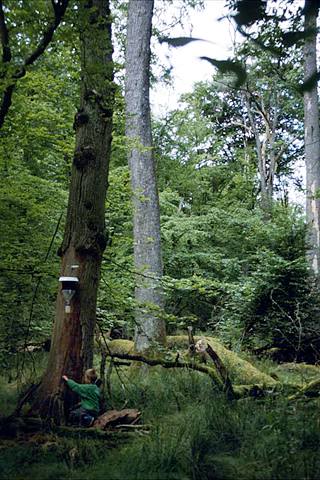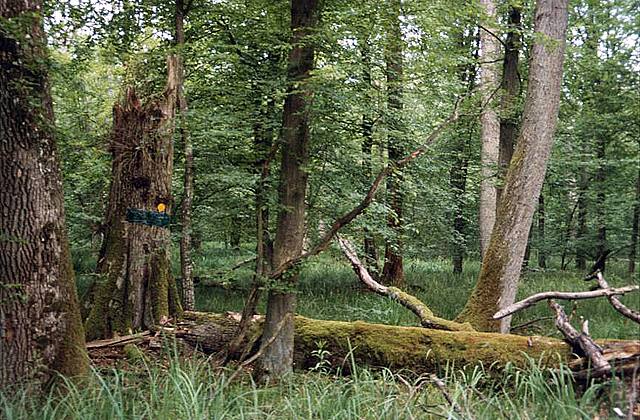| Bienwald
- Naturwaldreservate 1997 |
 |
|

Die Totholzkäferfauna
(Coleoptera) der Naturwaldreservate "Mörderhäufel" und "Stuttpferch"
im Bienwald
in der nördlichen
Oberrheinebene


In den Naturwaldreservaten "Mörderhäufel"
und "Stuttpferch" im Bienwald im südlichen Rheinland-Pfalz wurde in
den Jahren 1996 und 1997 eine Bestandserfassung zur Totholzkäferfauna
durchgeführt. Mit verschiedenen Fallen und manuellen Techniken wurden
insgesamt 183.464 Käfer in 1.085 Arten nachgewiesen. Mit 361 beziehungsweise
366 xylobionten Arten - gemeinsam: 440 Spezies - gehören die Flächen
zu den artenreichsten Reservaten in Deutschland. Diese große Vielfalt
wird einerseits durch die geographische Lage in der Oberrheinebene und
das damit verbundene günstige Makroklima, andererseits aber auch durch
die Größe des Waldgebietes und forstliche Nutzungsgeschichte
ermöglicht.


Naturwaldreservat Stuttpferch - Fensterfalle an toter
Eiche 1997. |

Naturwaldreservat Stuttpferch - Flugköderfalle
mit Taubenmist an toter Eiche 1997. |

Die Fauna der Naturwaldreservate zeichnet
sich durch eine große Zahl mediterraner Faunenelemente, seltener
und gefährdeter Arten aus. Insgesamt wurden 212 Käferarten der
Roten Liste Deutschlands, eine aus Deutschland unbekannte Art und 174 Erst-
und Wiederfunde für Rheinland-Pfalz oder Rheinhessen-Pfalz nachgewiesen.
"Mörderhäufel" und "Stuttpferch" besitzen damit eine gesamtstaatliche
Bedeutung beim Schutz und der Förderung waldtypischer Lebensgemeinschaften.


Naturwaldreservat Stuttpferch - Leimring an abgebrochener
Alteiche 1997. |

Die beiden Naturwaldreservate sind sich
hinsichtlich der Artenzusammensetzung sehr ähnlich und zeigen zahlreiche
gemeinsame Charakteristiken, beispielsweise einen hohen Anteil an Eiche
oder Nadelhölzer gebundener Arten, ein hoher Anteil licht- und wärmeliebender
Arten sowie eine sehr große Zahl mulm- und nestbewohnender Totholzkäfer.
Die reliktartige Präsenz an alte Baumbestände gebundener Arten
belegt einerseits eine ungebrochene Alt- und Totholztradition, andererseits
fehlen alte hohle Bäume und eine hieran angepaßte Fauna weitgehend.
Nachdem in beiden Reservaten zahlreiche alte Eichen infolge einer Gradation
des Schwammspinners (Lymantria dispar) abstarben, konnte eine artenreiche
und hochspezialisierte Totholzkäfer-Folgefauna beobachtet werden.

Bemerkenswerte Käfernachweise in den Naturwaldreservaten
1996 und 1997

The saproxylic beetles (Coleopter)
of the nature forest reserves "Mörderhäufel" and "Stuttpferch"
in the Bienwald, southern Rheinland-Pfalz, Germany. In the years 1996 and
1997, the saproxylic beetles were studied in the nature forest reserves
"Mörderhäufel" and "Stuttpferch" in the Bienwald in southern
Rheinland-Pfalz. Using different trapping and manual sampling techniques,
a total of 183,464 beetles of 1,085 species were recorded, among them 361
species of saproxylic beetles in "Mörderhäufel", 366 in "Stuttpferch",
and a total 440 saproxylic species in both sites. This remarkable species
diversity is due to the favourable macroclimatic conditions in the Oberrhein-Area
on the one hand, and to the size of the forest Bienwald and the history
of its management on the other hand. In these nature forest reserves numerous
mediterranean elements and rare and endagered species were recorded: a
total of 212 beetle species of the Red Data List of Germany, one first
record for Germany, and 174 first records or re-records (after 50 years)
for Rheinland-Pfalz or Rheinhessen-Pfalz. Therefore, "Mörderhäufel"
and "Stuttpferch" are attributed special significanca and priority in the
protection and support of forest ecosystems on a national level. Both nature
forest reserves were found to be similar in various respects: a high proportion
of species dependent on either oak or coniferous trees, a great number
of thermophilous species, and numerous saproxylic beetles living in rotting
wood and nests. The presence of species restricted to old woodland is a
result of extensiv forest management. Remarkable, however, the fauna associated
with dead hollow trees is almost completely absent. Following a mass gradation
of Lymantria dispar (Lepidoptera), which resulted in the death of numerous
old oak trees, a diverse and highly specialized species community of saproxylic
beetles was observed.

| Zitat:
Kurzfassung / Abstract aus: Köhler, F. (1999c): Die Totholzkäferfauna
(Coleoptera) der Naturwaldreservate "Mörderhäufel" und "Stuttpferch"
im Bienwald in der nördlichen Oberrheinebene. - Mainzer naturw. Archiv
(Mainz)
37, 213-280. |
|
|